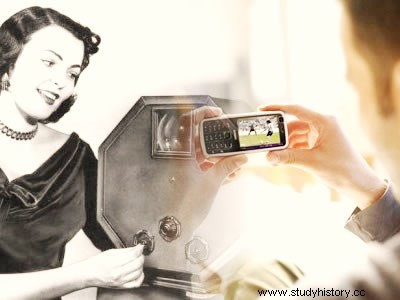
By Rainer Sousa
Historically, the interest in creating the television set can be found since the 19th century. At this time, great concepts developed in mathematics, physics and chemistry were the fundamental precursors of the technology used in the creation of TV sets. Around the 1840s, several scientists were studying the possibility of transmitting images over long distances. In the year 1842, Alexander Bain managed to carry out a project of telegraph sending an image.
In 1873, the British Willoughby Smith proved that selenium was a chemical substance capable of converting light energy into electrical energy. Using this principle, television could already be imagined as an electrical device that receives and transmits images. In 1884, the young Paul Niokow developed a disk with spiral holes capable of breaking an image into elements that were rearranged for transmission.
In the late 19th century, cathode ray tubes were being improved as transmitters of images at a distance. In the year 1920, Scotsman John L. Baird used the various principles already developed for this type of technology and built one of the first television models known. Contrary to other attempts, this scholar managed to greatly improve the clarity of the image and sound with the device he produced.
From then on, the television set was improved until it became more commercially viable. In 1923, Russian Wladmir Zworykin developed an image tube called an iconoscope. Excited about this achievement, the American company RCA hired its services and manufactured the Orticon. We had there, then, the first model of television to be produced on an industrial scale.
Reaching the 1930s, the television gained new repairs until it became a product of greater commercial viability. In March 1935, the Germans were largely responsible for making the first television broadcast. In the midst of Nazism, this type of technological resource was incredibly used to publicize the regime led by Adolf Hitler. Shortly thereafter, the French and British also invested in the construction of studios and the transmission of images.
Since that period, scholars interested in this type of technology have already tested some possibilities of transmitting color images. This feat was only achieved in 1954, when the North American broadcaster NBC used a system compatible with black and white televisions to transmit color images. In 1962, the Telstar satellite performed the first intercontinental transmission sending TV signals from the United States to the Old World.
In Brazilian lands, television appeared as a great technological novelty at the 1939 International Fair of Samples, which took place in the city of Rio de Janeiro. Almost ten years later, camera operator Olavo Bastos Freire broadcast a football match using improvised technology. Two years later, businessman Assis Chateaubriand opened Tupi, the first commercial television broadcaster in the country.
